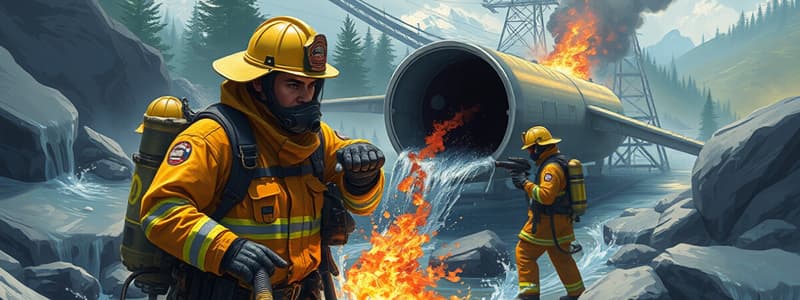Podcast
Questions and Answers
What is the minimum flow capability of a typical aerial apparatus per deck gun?
What is the minimum flow capability of a typical aerial apparatus per deck gun?
- 500 gpm
- 1000 gpm (correct)
- 1250 gpm
- 750 gpm
What is the role of the forward pumper in the 'big water' evolution?
What is the role of the forward pumper in the 'big water' evolution?
- To lay supply lines from the key pumper
- To position far from the ladder company
- To connect to the hydrant only
- To supply water to the ladder company (correct)
Which component is necessary for establishing a 'big water' evolution?
Which component is necessary for establishing a 'big water' evolution?
- Multiple deck guns on the key pumper
- A single hose from the ladder company
- A reverse lay from the hydrant
- Two supply lines between the forward and key pumper (correct)
In the most efficient 'big water' evolution, what does the key pumper do?
In the most efficient 'big water' evolution, what does the key pumper do?
What is the purpose of positioning the forward pumper close to the ladder company?
What is the purpose of positioning the forward pumper close to the ladder company?
Flashcards are hidden until you start studying
Study Notes
Master Stream Supply Lines
- Establishing supply lines for master stream operations is crucial for ladder companies to receive adequate water volumes.
- Aerial apparatus can typically flow up to 1000 gallons per minute (gpm) per deck gun, with most having two deck guns.
- Aerial platforms or ladders are classified as appliances that can supply over 1000 gpm.
- Standard "big water" hose evolutions involve a forward pumper, a key pumper, and two supply lines connecting them.
- Water is pumped by the key pumper to support the two supply lines for effective water delivery.
- Positioning the forward pumper close to the ladder company minimizes the length of the supply line and reduces friction loss.
- The most efficient evolution involves the forward pumper completing a forward lay from the hydrant straight to the ladder company.
- The key pumper performs a reverse lay from the forward pumper back to the hydrant, enabling a second supply line for enhanced capacity.
Studying That Suits You
Use AI to generate personalized quizzes and flashcards to suit your learning preferences.




